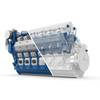Queen Mary 2 Sets Sail with GE LM2500s
“We are delighted that our LM2500+ gas turbines were selected to power this elegant and historic achievement in naval architecture and engineering,” said Karl Matson, general manager of GE Marine. “This project also marks a milestone for GE, as the LM2500+ gensets are being used for the first time in a ‘dual gas turbine’ installation on a cruise ship in a combined diesel and gas turbine arrangement. The powerful LM2500+s enable the ship to meet its maximum speed of 30 knots,” Matson added.
Gas Turbines
The two GE LM2500+ aeroderivative gas turbine-generators for the Queen Mary 2 are used in a COmbined Diesel And Gas (CODAG) propulsion system with four diesel generator-sets. The gas turbines were manufactured at GE Marine’s Evendale, Ohio facility; the generator sets were packaged by GE Energy in Houston, Texas.
Each gas turbine-generator set contributes 25 megawatts to the ship’s overall 118 megawatts of installed power. Power produced in this electric drive configuration is used for propulsion as well as onboard power. GE specially designed the two LM2500+ packages for Chantiers de l’Atlantique, the Queen Mary 2 shipyard, to be some 35 tons lighter than previous LM2500+ marine gas turbine installations. According to Chris Dalston, manager of commercial marine sales for GE Energy, “What makes this application unique is that the compactness and low noise and vibration characteristics of the packages. These design features allowed the shipbuilder flexibility, especially with respect to the placement of the gas turbine gensets. The volume and weight of ducting for the combustion intake, exhaust and package ventilation are significantly reduced, thereby increasing the ships’ available space for cabins and public areas.”
The redesigned package also features the next-generation Woodward Micro Net Digital Control turbine control system. The controls manage all the systems of the package, including engine fuel management, package sequencing, package condition monitoring and interfacing to other systems aboard the ship.










